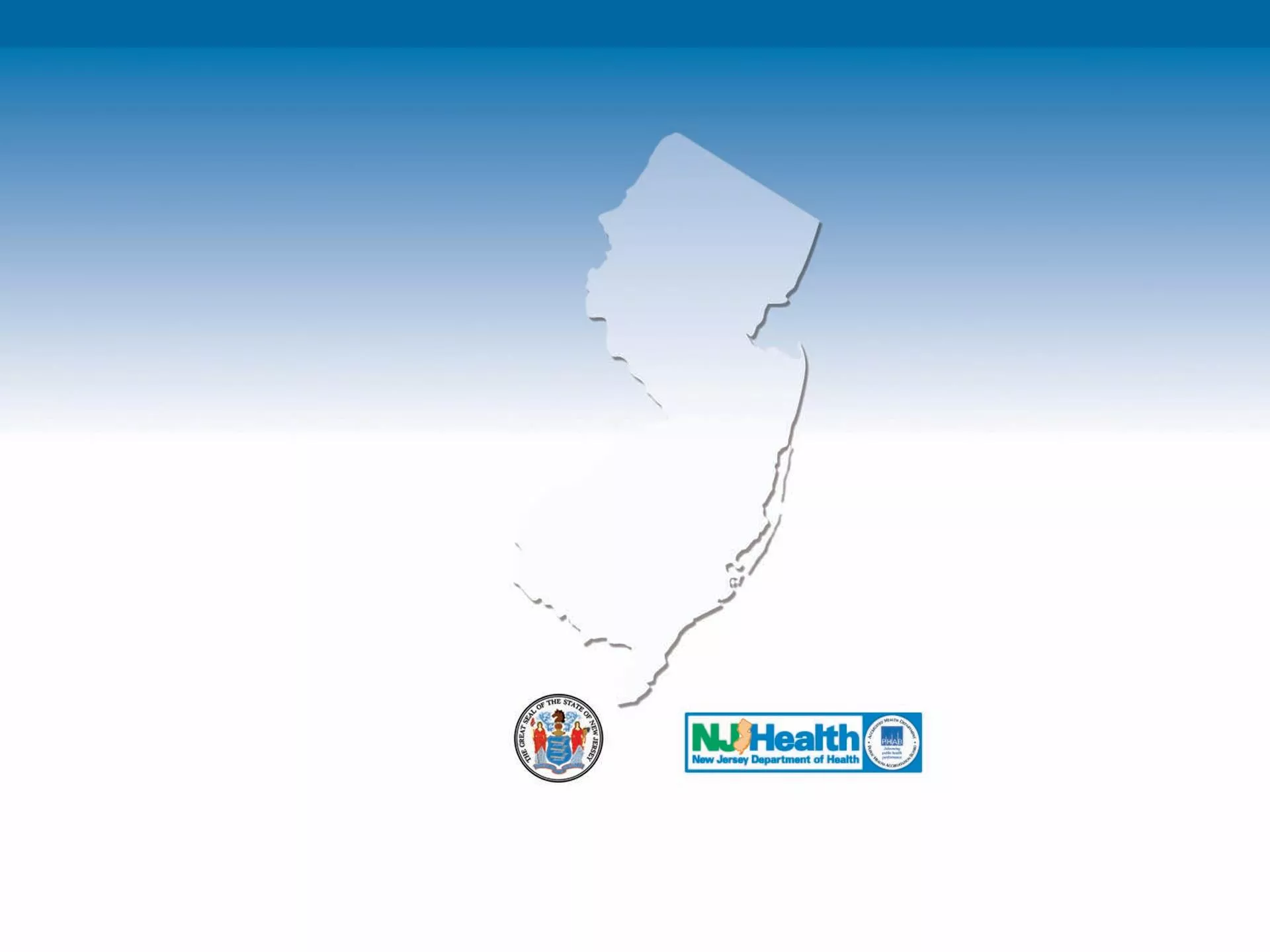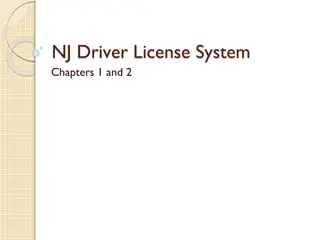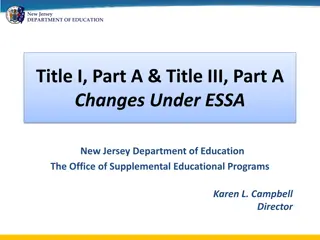Understanding the New Jersey Patient Safety Act and Reporting Process
The New Jersey Patient Safety Act, enacted in April 2004, aims to enhance patient safety, minimize adverse events, and improve system/facility performance. It emphasizes confidentiality, promotes a blame-free culture, and encourages evidence-based practices. Healthcare facilities, including ASCs, are required to report serious preventable adverse events to ensure patient well-being and accountability.
Download Presentation

Please find below an Image/Link to download the presentation.
The content on the website is provided AS IS for your information and personal use only. It may not be sold, licensed, or shared on other websites without obtaining consent from the author. Download presentation by click this link. If you encounter any issues during the download, it is possible that the publisher has removed the file from their server.
E N D
Presentation Transcript
The New Jersey Patient Safety Act And Reporting Process Patient Safety Reporting System ASC Training Mercer County Community College November 29, 2018 December 4, 2018
Patient Safety Reporting System The Presentation will Review 1. Patient Safety Act and Reporting Requirements 2. Adverse Event Reporting Process 3. Root Cause Analysis Reporting Process 4. New Facility User Registration Process 2
1. The Patient Safety Act and Reporting Requirements The Patient Safety Act (C.26:2H-12.23*) Enacted in April 2004 Enhance Patient Safety Minimize Number of Adverse Events Minimize Patient Harm Improve System/Facility Performance * Link available on the NJ Patient Safety website 3
1. The Patient Safety Act and Reporting Requirements Patient Safety Act continued Confidentiality Protection Encourages honest, critical self-analysis Restricts Discoverability Admissibility Disclosure of documents, materials and information Be clear about separation between Patient Safety and Quality Improvement activities 4
1. The Patient Safety Act and Reporting Requirements Patient Safety Act continued Promotes a culture of safety Encourages change and improvement Blame-free environment Collaboration between all levels and disciplines of staff Strive for Zero adverse events, not just better than the national average Commit resources to improvement 5
1. The Patient Safety Act and Reporting Requirements Patient Safety Act continued Non-Punitive No public reports are issued by PSRS that list individual facilities Encourages evidence-based practices Collegial 6
1. The Patient Safety Act and Reporting Requirements Patient Safety Act continued NJ Licensed healthcare facilities (including one room ASCs) must report every serious preventable adverse event A negative consequence of care that results in unintended injury or illness Discrete, auditable and clearly defined occurrence Preventable: an event that could have been anticipated and prepared against, but occurs because of an error or other system failure. Frequently unable to make this determination at time of event Results in death or loss of a body part, or disability or loss of bodily function Some event types have no threshold of injury such as RFOs, Wrong Surgery Lasts more than 7 days or present at discharge 7
1. The Patient Safety Act and Reporting Requirements Patient Safety Regulations (N.J.A.C. 8:43E-10*) requires facilities to**: Establish a Patient Safety Committee Conduct ongoing analysis and application of evidence-based patient safety practices Conduct analyses of near-misses, with particular attention to serious preventable adverse events Develop a Patient Safety Plan Review and revise plan as necessary, at least every 3-years Foster attitudes, beliefs and behaviors supporting open communication in the facility Review results of each RCA and, as appropriate, recommend modifications of systems, technology, policies or procedures * Link available on the NJ Patient Safety website ** List is not inclusive 8
1. The Patient Safety Act and Reporting Requirements Patient Safety Regulations continued Report Serious Preventable Adverse Events that occur in the facility to DOH or DHS If a facility discovers an event subject to mandatory reporting that occurred in a different facility, the discovering facility shall notify DOH but does not need to perform an RCA The identity of the facility at which the event occurred should be reported to DOH if known Conduct Root Cause Analyses (RCAs) of Serious Preventable Adverse Events Submit Root Cause Analyses of Serious Preventable Adverse Events to DOH or DHS 9
1. The Patient Safety Act and Reporting Requirements. Patient Safety Regulations continued Disclose the Serious Preventable Adverse Event to the Patient or Health Care Representative within 24 hours of discovery Record the time, date, and individuals present when disclosure was made and to whom it was disclosed in the medical record Record a statement that the occurrence of a serious preventable adverse event was disclosed in the medical record Inform employees/health care professionals about their option to file anonymous reports of preventable adverse events 10
1. The Patient Safety Act and Reporting Requirements Patient Safety Regulations continued Event Report must be submitted into the online Patient Safety Reporting System no later than 5 business days after discovery The date and time of discovery is the date and time anyone associated with the ASC (including the physician) becomes aware of a serious preventable adverse event The physician or surgeon is a member of the healthcare team. 11
1. The Patient Safety Act and Reporting Requirements Patient Safety Regulations continued PSRS reviews event report in online system PSRS determines whether a Root Cause Analysis (RCA) is required based on the rules and regulations and notifies the facility If the event is reportable, the RCA must be submitted to PSRS within 45 calendar days from initial event report 12
2. Adverse Event Reporting Process Reporting Categories* Care Management Environmental Product or Device Surgery-Related Patient Protection * List of reportable events are located in the Patient Safety Regulations 13
2. Adverse Event Reporting Process Surgery-Related Events Wrong Surgery (wrong site, procedure, patient) Surgery initiated (whether or not completed) on a patient that is not consistent with the patient s documented informed consent Wrong site Wrong procedure Wrong patient Retention of a Foreign Object Excludes objects intentionally implanted as a part of a planned procedure, objects present prior to the procedure intentionally retained and retained broken microneedles 14
2. Adverse Event Reporting Process Surgery-Related Events continued Surgical Intra/Post-op Coma/Death/Other Includes cases where anesthesia was administered regardless of whether the planned procedure was carried out Includes cases where adverse events occur within 24 hours of the procedure in any patient of an ambulatory surgery facility Surgical Other Generally used for any other surgical event that does not fit into the previous surgical event categories 15
2. Adverse Event Reporting Process Other Indicators of Reportable Events Unplanned hospital admission Visit to ED or other healthcare facility (e.g., Urgent Care Center) following discharge from ASC Intra/Post operative complications not limited to Aspiration Pneumothorax Organ Perforation Moderate to severe bleeding Serious infections 16
2. Adverse Event Reporting Process Threshold of Injury Some event types have no threshold of injury such as Retained Foreign Object Wrong Site, Wrong procedure, Wrong patient Most event types have a threshold of injury requirement in the regulations Coma, death, loss of body part, disability or loss of bodily function lasting more than seven days or still present at discharge 17
2. Adverse Event Reporting Process Threshold of Injury continued Important for PSRS to determine if the event meets the threshold of injury when deciding whether the event will require an RCA PSRS needs to determine how this event affected the patient Include this information in the Event Report 18
2. Adverse Event Reporting Process Description of the Adverse Event The Initial Event submission should contain details about the impact on the patient: The type of injury/harm to the patient The severity of the injury/harm Duration of injury/harm Pertinent lab and imaging results Impact on the patient s Activities of Daily Living and function Chronological timeline Often need information from hospital about what happened once the patient was transferred or presented for treatment after surgery 19
2. Adverse Event Reporting Process Description of the Adverse Event continued If a patient is either transferred, or subsequently presents to a different facility for care following the event, additional information from that facility providing follow-up care may be required. Examples may include transfer from an ambulatory surgery center to a hospital, from one hospital to another or an emergency department visit. In these situations, the facility at which the event occurred may need to reach out to the facility that provided follow-up treatment through appropriate channels consistent with the facility s policies to obtain the required information. 20
2. Adverse Event Reporting Process Description of the Adverse Event continued The following information from the facility providing follow-up care may be required: Date/time of the transfer/admission and discharge Diagnosis upon presentation and the discharge diagnosis Results of pertinent diagnostic testing Treatments received including any new medications prescribed at discharge 21
2. Adverse Event Reporting Process Immediate Clinical Actions Provide the clinical actions taken for the patient following the event Describe the immediate treatment provided to the patient in response to the event Timeline Clinical outcome 22
2. Adverse Event Reporting Process Immediate Corrective Actions Provide the immediate corrective actions taken in response to the event. Should include the specific procedures implemented to reduce the likelihood of recurrence of this event List any additional reports provided to other organizations (e.g., equipment manufacturers, pharmaceutical manufacturers) concerning this event 23
2. Adverse Event Reporting Process The Online System for Reporting Adverse Events The two-hour window The 2 hour window The 2 window The 2h window Did I mention the two hour window? 24
2. Adverse Event Reporting Process Event Review by PSRS Possible Review Outcomes: 1. Reportable RCA Required 2. Reportable RCA Not Required 3. Not Reportable 4. Less Serious or Near Miss 5. Need More Information 25
2. Adverse Event Reporting Process 1. Reportable RCA Required The Event is subject to the Patient Safety Act and Reporting Requirement A root cause analysis (RCA) must be completed by the facility and submitted to PSRS An email is sent to the FacAdmins The RCA Due Date will be provided in an email to the FacAdmins and can also be located in the Communication Log Note: PSRS must be added as a safe sender so PSRS emails do not go to your spam folder 26
2. Adverse Event Reporting Process 1. Reportable RCA Required continued A Facility User must log into the PSRS to read the Determination, which will be located in the communication log for that event, and respond accordingly There are usually comments from the event reviewer that should be reviewed and addressed when the RCA is submitted 27
2. Adverse Event Reporting Process 2. Reportable RCA not Required The Event is subject to the Patient Safety Act and Reporting Requirements A root cause analysis (RCA) does not need to be completed by the facility Example: RFO discovered but retained at a different facility An email is sent to the FacAdmins A Facility User must log into the PSRS to read the Determination, which will be located in the communication log for that event There may be comments from the event reviewer which should be reviewed 28
2. Adverse Event Reporting Process 3. Not Reportable PSRS recommends internal analysis A root cause analysis (RCA) does not need to be submitted to PSRS An email is sent to the FacAdmins A Facility User must log into the PSRS to read the Determination, which will be located in the communication log for that event There may be comments from the event reviewer which should be reviewed 29
2. Adverse Event Reporting Process 4. Less Serious or Near Miss PSRS recommends internal analysis A root cause analysis (RCA) does not need to be submitted to PSRS An email is sent to the FacAdmins A Facility User must log into the PSRS to read the Determination, which will be located in the communication log for that event There may be comments from the event reviewer which should be reviewed 30
2. Adverse Event Reporting Process 5. Need More Information PSRS makes comments to determine the status of the event An email is sent to the FacAdmins A Facility User must log into the PSRS and open the event to read the comments and respond accordingly 31
2. Adverse Event Reporting Process 5. Need More Information continued Respond to all comments by editing the event The description of the event is an unlimited text field Resubmit the event to PSRS There may be more than 1 cycle of responding to comments 32
2. Adverse Event Reporting Process Other Communications from PSRS 1. General Comment or Email-Other There is a new comment available from the Patient Safety Reporting System. Please log into the web based system and check the Communication Log to review the comment and respond accordingly 2.Access Communications by Communication Log--General Comment or E-mail Other 33
2. Adverse Event Reporting Process Other Communications to PSRS 1. General Comment or Respond to PSRS Comment 2.Send Communication through Communication Log--General Comment 34
2. Adverse Event Reporting Process Extensions for Events and RCAs May be granted upon request Send request with rationale as a comment through online system for that Event/RCA Some extensions granted automatically if time frame for event review is lengthy 35
3. Root Cause Analysis Reporting Process Root Cause Analysis A process to improve patient safety Emphasis on improving and redesigning systems and processes Emphasis not on individual performance Educational opportunity Nonpunitive 36
3. Root Cause Analysis Reporting Process Root Cause Analysis The purpose of the RCA is to uncover the factor(s) that led to and caused a serious preventable adverse event. It is not intended to assign blame to individuals or to organizations. Only by determining the underlying systemic causes of an adverse event can an effective action plan be formulated to minimize the chances of reoccurrence. The goal and purpose of the Patient Safety Act is to improve system processes and implement best practices in order to prevent similar events from recurring. 37
3. Root Cause Analysis Reporting Process RCA Required Components N.J.A.C. 8:43E-10.6(l)* requires the following RCA components**: A description of the event and the adverse outcome An analysis of why the event happened Direct causes(s) Potential underlying causes related to design/operation of facility systems The corrective actions taken for the patient(s) * Link available on the NJ Patient Safety website ** List is not inclusive 38
3. Root Cause Analysis Reporting Process RCA Required Components continued The method to identify other patients having potential to be affected by the same event and corrective action(s) The measures to be put into place or the systematic changes needed to reduce the likelihood of similar events How the corrective action(s) will be monitored to assess their impact 39
3. Root Cause Analysis Reporting Process RCA Resources RCA Report Questions Initial Event Reviewer s Comments Literature Review Information Consulted Literature cited in ALL RCAs Information in this field is accessible to all facilities RCA Form Definitions 40
3. Root Cause Analysis Reporting Process RCA: General Information RCA Team Ad hoc under Patient Safety Committee Distinct from QI activities Multidisciplinary and diverse Leadership involvement Subject matter experts Front line staff Staff involved in event? Commitment to RCA Process Resources 41
3. Root Cause Analysis Reporting Process RCA: General Information Prior Similar Events Review number and trend of similar events in the same Event Classification Review prior root causes and action plans Review effectiveness of prior action plans Review how serious preventable adverse events are identified 42
3. Root Cause Analysis Reporting Process RCA: Facts of the Event Detailed chronological narrative Who, what, when, where and how Clear, complete and understandable Include the direct cause of the event Include any factors that may have contributed to the occurrence of the event. 43
3. Root Cause Analysis Reporting Process RCA: Facts of the Event continued Do NOT copy and paste medical records or autopsy reports into the RCA Summarize the pertinent information that is related to the event (e.g., lab results, diagnostic studies, etc.) Remember that the MyNJ Portal has a two-hour time limit 44
3. Root Cause Analysis Reporting Process RCA: Facts of the Event continued Answer all Reviewer comments/questions Helps provide a complete picture of the event and analysis Check for Event Reviewer comments which should be addressed in the RCA Some facilities will copy and paste the comments/questions into a word document Respond to each comment/question Copy and paste this information into RCA: Facts of the Event item #2, which has an unlimited field of characters 45
3. Root Cause Analysis Reporting Process RCA: Facts of the Event continued Provide enough detail so that a person unfamiliar with the event can understand what happened Request other staff to review for clarity The section RCA: Facts of the Event item#2 is an unlimited text field Auto-populates information from the event report VERIFY information is accurate Include detailed facts of the entire event Add any additional pertinent information regarding the event. 46
3. Root Cause Analysis Reporting Process RCA: Facts of the Event continued RCA Discussion Provide a comprehensive description of the analysis process and findings Document all systems/processes reviewed Explain how the RCA Team reached its conclusions RCA Reviewer was not present at the time of the event or for the RCA Discussions 47
3. Root Cause Analysis Reporting Process Root Cause Use the Facts of the Event to examine why the event occurred When choosing a root cause, fully explore all other options before choosing Other RCA Form Definitions on PSRS website Start with a broad review of all systems/processes No process is above scrutiny No preconceived beliefs Honest and open discussion Focus on prevention 48
3. Root Cause Analysis Reporting Process Root Cause Look for modifiable risk factors Human error and violations of procedure must have a preceding cause Must continue to ask Why? Often more than 1 root cause Evidence-based literature review 49
3. Root Cause Analysis Reporting Process Causality Statement Connects the root causes with the event X (cause) increased the likelihood that Y (event) occurred 50


























